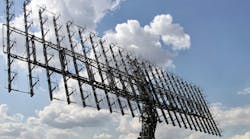Millimeter-wave and submillimeter-wave frequencies are of growing interest as wireless applications continue to consume signals and bandwidths at lower RF and microwave frequencies. Whether for high-data-rate communications links or automotive radar systems, millimeter-wave signals must be steered and controlled.
With that in mind, Kamal Sarabandi and researchers at the Radiation Laboratory of the University of Michigan at Ann Arbor developed a novel traveling-wave antenna array structure with meandered hollow rectangular waveguide as the propagating medium. The antenna consists of more than 600 patch elements packed into a size of only 45 × 8.5 × 1.25 mm and weighing less than 4.5 g.
The antenna array was designed to generate a narrow beamwidth in both azimuth and elevation planes, about 2.5 deg., with ±25 deg. beamsteering capability for frequency sweeps from 230 to 245 GHz. It achieves overall gain of about 29 dBi with radiation efficiency of more than 55% over the full frequency range. To minimize unwanted modes and avoid the problems associated with fabricating antennas on uniform dielectric substrates, the patch array was formed with an air substrate around the antenna to eliminate propagation of surface waves and minimize electromagnetic coupling among patch antenna elements.
The beamsteered antenna is formed through microfabrication with three wafers. The first wafer contains the waveguide trenches and an E-plane bend step transition for probe feeding the antenna. A multiple-site masking and etching process is used to etch the trenches in a 1000-µm-thick silicon wafer. The second wafer, which is 250-µm-thick silicon, contains the cavity-backed trench of the patch array etched on the top side with a through-wafer slot etched from the reverse side. The patch array is formed by patterning gold on a thin layer of Parylene deposited on a third wafer as a membrane layer. By dissolving the membrane layer, alignment accuracy of better than 3 µm can be achieved for the antenna array with this process.
See “A Novel Frequency Beam-Steering Antenna Array for Submllimeter-Wave Applications,” IEEE Transactions on Terahertz Science and Technology, Vol. 8, No. 6, November 2018, pp. 654-665.

